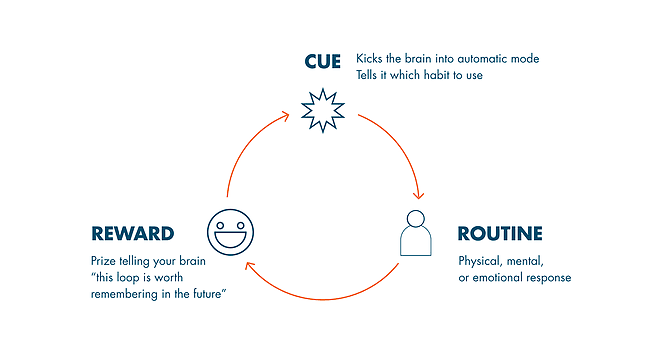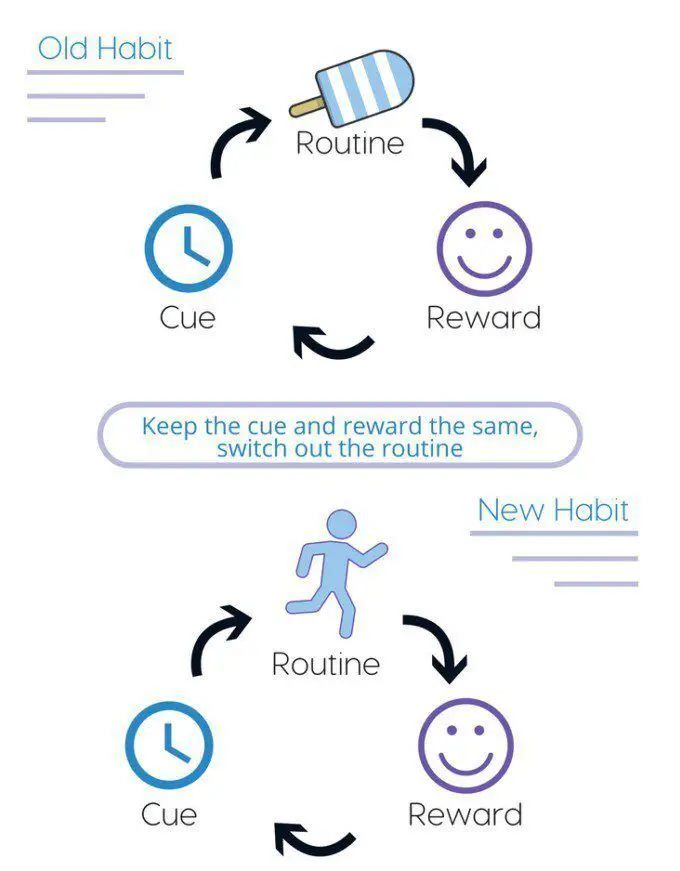How many times have you resolved to eat better this year, only to find yourself succumbing to your old bad junk food habits within a few weeks?
If you’re like most people, the answer is “too many times to count.”
It can be tough to break bad eating habits, especially if you don’t know what’s triggering them. Unfortunately, most diet and weight loss programs don’t specifically look at what triggers a binge or unhealthy eating.
In this blog post, we’ll discuss how to catch your eating triggers and how to break bad habits for good!
How Habits Work

Habits have three parts: cue, routine, and reward.
The cue is the trigger that tells your brain it’s time to do the habit.
The routine is the actual behavior – in this case, eating.
And the reward is something that satisfies you and makes you want to do the habit again.
For example, let’s say you have a bad habit of bingeing on junk food when you watch TV at night.
In this case, the cue would be turning on the TV, the routine would be eating junk food, and the reward would be feeling satisfied or enjoying the taste of the junk food.
Habits can be tough to break because they’re so ingrained in our daily routines. But if we can identify the cue and the reward, we can begin to break the habit.
How to Catch Your Eating Triggers
The first step to breaking a bad eating habit is identifying your triggers.
To do this, you’ll need to keep a food journal for at least two weeks.
In your journal, be sure to track:
- What you ate and when you ate it (but not to the detail of how many calories)
- How you were feeling before, during, and after eating
- Any other factors that may have influenced your decision to eat (e.g., boredom, stress, fatigue)
By tracking these factors, you’ll begin to see patterns in your eating habits.
For example, you may notice that you’re more likely to binge on junk food when you’re bored or stressed.
Or you may notice that you tend to eat more unhealthy foods late at night.
Once you’ve identified your triggers, you can begin to work on breaking the habit.
How to Break a Bad Eating Habit

Now that you know what’s triggering your bad eating habits, it’s time to break the habit for good!
There are a few different ways to do this:
- avoiding your trigger altogether (e.g., not watching TV at night)
- substituting a healthier behavior for the bad one (e.g., eating healthy snacks instead of junk food when you watch TV)
- changing the way you think about food (e.g., thinking of junk food as “treats” instead of everyday snacks)
The best way to break a bad habit is to find a method that works for you and stick with it!
If you slip up, don’t beat yourself up – just get back on track and continue working towards your goal.
If you can just stick with a method, then you’ll be able to solve all sorts of problems in your life like anxiety or depression.
But how do you stick with a method?
One handy tip to stick with a method is to think about the rewards you get from your original bad habit.
For example, if you like the taste of junk food, try to find healthier foods that are just as delicious.
Or if you find yourself bingeing when you’re bored, try to find other activities that are enjoyable and can take your mind off of food.
There are endless possibilities when it comes to breaking bad habits – it just takes a little creativity and perseverance!
If you’re struggling to break a bad eating habit, remember that you’re not alone.
There are many resources available to help you on your journey.
The most important thing is to keep trying – eventually, you’ll find a method that works for you!
Take Tiny Steps
Instead of trying a big activity, go small.
When forming new habits, tiny steps are the key to making long term change.
For example, if you want to start working out more, begin by walking for five minutes a day.
Once that becomes a habit, you can gradually increase the amount of time you walk each day.
The same goes for eating – instead of completely overhauling your diet, start with one small change, like adding an extra serving of fruits, supplement, and vegetables to your daily routine.
Habits take time to form, so be patient and keep at it! You’ll get there eventually.
Why Tiny Steps Work
Tiny steps work because they’re easy to do and they don’t require a lot of time or effort.
This means that you’re more likely to stick with the new habit, even when life gets busy.
In addition, taking tiny steps will help you build confidence in your ability to change.
As you start to see results from your small changes, you’ll be motivated to keep going and make even bigger changes.
You Don’t Have To Be Perfect
One of the biggest myths about forming new habits is that you have to be perfect.
This simply isn’t true!
In fact, trying to be perfect can actually set you up for failure.
If you miss a day of working out, or if you eat an unhealthy meal, don’t beat yourself up – just get back on track and continue working towards your goal.
Remember, progress is more important than perfection.
Plus, since you’re taking tiny steps, it’s easy to get back on track!
Other Common Mistakes
In addition to thinking you have to be perfect, there are a few other common mistakes people make when trying to form new habits.
Here are a few to avoid:
Trying to change too many things at once – When you’re first starting out, it’s best to focus on one or two habits.
If you try to change everything at once, you’re more likely to get overwhelmed and give up.
Not being specific enough – When setting goals, be as specific as possible.
For example, instead of saying you want to “eat healthier,” try setting a goal like
“I will eat three servings of fruits and vegetables every day.”
This way, you know exactly what you need to do to reach your goal.
Not having a plan – Once you’ve decided what changes you want to make, it’s important to have a plan for how you’re going to do it.
Without a plan, it’s easy to get sidetracked and give up on your new habits.
So take the time to sit down and figure out exactly what steps you need to take to reach your goals. If you aren’t sure about your goals, try journaling “backwards””“!
Making these small changes in your life can be daunting, but remember that even tiny steps can lead to big results!
Just keep at it, and eventually, forming new habits will become second nature. And before you know it, you’ll be well on your way to reaching your goals!
So there you have it – everything you need to know about breaking bad eating habits!
Just remember to take it one step at a time, and eventually, you’ll reach your goals. Good luck!



